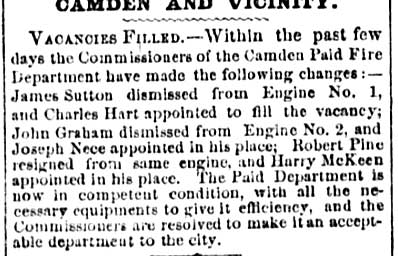|
On September 2, 1869 City Council
enacted a
municipal
ordinance creating a paid fire department. It provided for the
annual
appointment of five Fire Commissioners, one Chief Marshal (Chief
of
Department)
and two Assistant Marshals. The City was also divided into two
fire
districts. The boundary line ran east and west, starting at
Bridge
Avenue and following the tracks of the Camden and Amboy Railroad
to
the city limits. District 1 was south of this line and District
2 was
north. The commissioners also appointed the firemen who were
scheduled to work six 24 hour tours per week.
William
Abels, from the
Weccacoe Hose Company No. 2 was appointed Chief Marshal with
William
J. Mines, from the Independence Fire Company No. 3 as
Assistant
Marshal
for the 1st District, and
William H.
Shearman as the Assistant Marshal
for the 2nd District.
Abels
had served with the volunteer fire
departments of Philadelphia, Mobile, Alabama and Camden for
sixteen
years prior to his appointment as Chief of the paid
force.
On
November 10, 1869 City Council purchased the Independence
Firehouse,
the three-story brick building at 409
Pine
Street, for $4500. The
building was designated to serve as quarters for
Engine Company
1
and
the 1st District. On October 29, 1869 City Council authorized
construction of a two-story brick building on the northwest
corner of
Fifth
and
Arch
Streets as quarters for
the 2nd
District. On November
25th the Fire Commissioners signed a contract with M.N. Dubois in
the
amount of $3100 to erect this structure. The 2nd District would
share
these quarters with Engine
Company 2 and the
Hook
& Ladder Company
and the facility would also serve as
department
headquarters
for the new paid force. The original contract remains part of
the
Camden County Historical Society collection.
|
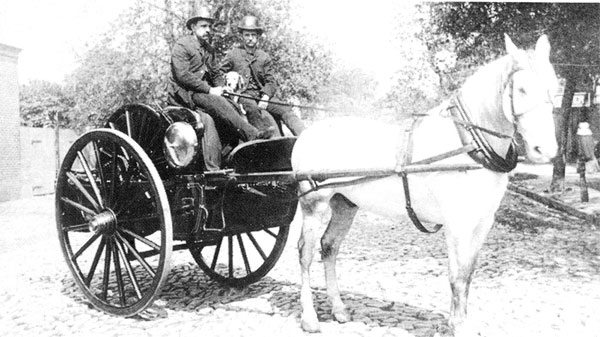
|
|
Engine
Company 2 with 1869 Silsby Hose
Cart. Photo
Circa 1890. Note badges
upon derby hats worn by Fire Fighters.
|
Two
Amoskeag second class, double pump, straight frame steam engines
were
purchased at a cost of $4250 each. Two Silsby two wheel hose
carts,
each of which carried 1000 feet of hose, were another $550 each
and
the hook & ladder, built by Schanz and Brother of
Philadelphia was
$900. Each engine company received a steam engine and hose cart.
Amoskeag serial #318 went to
Engine Company
1, and
serial #319 to
Engine Company
2. The
Fire Commission also secured the services of the
Weccacoe and Independence steamers in case of fire prior to
delivery
of the new apparatus. Alfred McCully of Camden made the
harnesses for
the horses. Camden's Twoes & Jones made the overcoats for
the new
firemen and a Mr. Morley, also of Camden, supplied the caps and
belts
which were manufactured by the Migeod Company of Philadelphia.
The new
members were also issued badges.
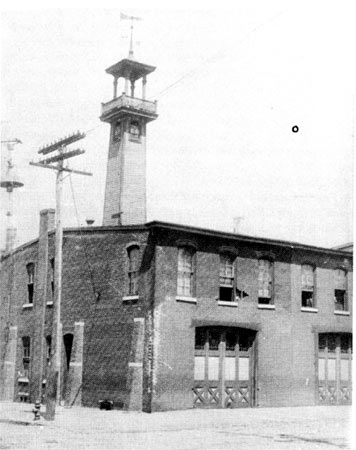
|
This
is the earliest known photo of fire headquarters
on the
northwest
corner of
Fifth
and
Arch
Streets. Originally built in 1869, the
building shows signs of wear some twenty years
later.
Note the
weathervane shaped like a fireman's speaking
trumpet
atop the tower.
Also, the fire alarm bell is pictured to the
left of the
telegraph
pole above the rooftop. The bell was removed
from the
building once
the fire alarm telegraph system was expanded and
in good
working
order.
|
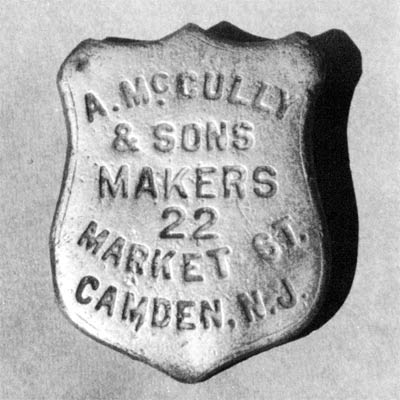
|
This
maker's plate once was attached to a harness
made by
A. McCully &
Sons, 22 Market Street, Camden, New Jersey.
This
firm provided the
first harnesses for the paid fire department
in
1869.
|
Badges
worn by the marshals, engineers, stokers and engine drivers bore
the
initial letter of their respective positions and their district
number. The tillerman and his driver used the number "3" to
accompany their initial letter. The extra men of the 1st
District
were assigned badges 1-10; 2nd District badges were numbered
11-20 and
the extra men of the hook & ladder wore numbers
21-30.
Although
the Fire Commission intended to begin operation of the paid
department
on November 20, 1869, the companies did not actually enter
service
until December 7th at 6 P.M. because the new apparatus and
buildings
were not ready. The new apparatus was not tried (tested) until
December
9th.
The
new members
of Engine
Company 2
were:
|
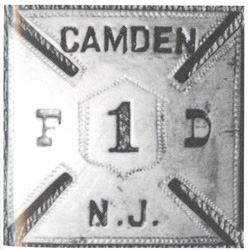
|
The
first style of breast badge worn by members
of the
career department
in the City of Camden. 1869. (Courtesy of
the
C.C.H.S. Collection).
|
Robert
Pine resigned from service with the Camden Fire Department on
April 2, 1870.
Robert
Pine was the son of William and Margaret Pine, and was born in
New
Jersey around 1840. He appears in the 1870 Census in Camden's
Middle
Ward with wife Mary Elizabeth, daughter Anna and son Harry. The
1872
Camden City Directory shows him living at 309 Taylor Avenue.
Another
son, benjamin
f.
pine,
was born in May of 1873.
Robert
Pine served briefly with the Camden Police Department in the
late 1870s.
On March 20, 1877
Robert
Pine was appointed to serve as a policeman in Camden by
Mayor
James
Ayers, to begin serving on April 1, 1877. Charles
Daubman as
appointed Chief of Police. The other men who were appointed were
Jonathan Watson, Andrew Baird, John T. Miller, Daniel Johntra,
Charles
Hart, William Smith from the Third Ward, William
Hawkins, Isaac
Ellis, John W. Campbell, John E. Anderson, John Brown, Mark
Sheldon,
Thomas Conway, John
Furey and
William Smith from the Eighth Ward. Charles Daubman and
Robert
Pine had previously served as members of the Camden Fire
Department.
The
1880 Census shows Robert Pine living with his parents and
children at
333 Mickle Street, along with a sister. In
the late 1890s Robert Pine was living at 335
Berkley
Street and working
as a day laborer. Also at home were his son, Benjamin F. Pine,
mother
Margaret Pine, and sister Amy Pine. Robert Pine was still at
this
address when the Census was taken
in the summer of 1900, and in February of 1902. Robert Pine died
of
pneumonia at his home on February 11, 1902.
Robert
Pine's son, Benjamin
F.
Pine,
also served briefly with the Camden Fire Department.
|
